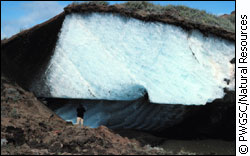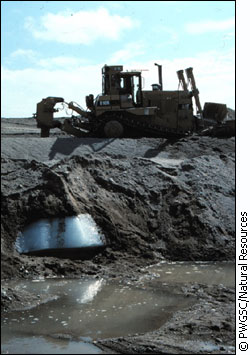|
Northern
ground sinking beneath our feet
By Olivia Fernandez
OTTAWA —
When Christopher Burn sets
foot in Mayo every summer, he feels like he’s
home. Although he lives and teaches in Ottawa, his scientific
research regularly takes him to the community that’s
nestled in central Yukon.
 |
| Cross-section of a mound
of ice called a "pingo" in Northern Canada. |
For some, scrutinizing the effects of thawing permafrost
may seem dull, but Burn is certain it takes a unique
individual to be a northern research scientist.
"You need to be happy to live in a remote environment
for extensive lengths of time, somebody who doesn’t
mind camping, doesn’t mind what they eat, where
they sleep. You need to be somebody who can get on with
anybody."
Burn had to do just that when he started committing
to long field investigations in places like Mayo in
the Yukon and most recently, the Mackenzie Delta in
the Northwest Territories.
He has been working in these regions for the past twenty
years, trying to determine the response of permafrost
to climate change. To him, permafrost is more than just
ground that remains below 0 C. It is the unyielding,
precious layer underneath the surface terrain that took
thousands of years to grow. A third of Canada sits on
this layer which can be up to 500 m thick.
Thawing ground
Burn says thin layers have been melting in recent
years because the earth’s temperature is warming.
This has affected the construction of buildings and
pipelines, since thawing causes slippery slopes, water
pools and sinking terrain. Burn’s research tries
to prove that global warming is a real phenomenon.
Throughout the year, he and his research students fly
north in helicopters, armed with water jets to drill
holes into permafrost. They put electrical sensors inside
these holes to measure the current temperature. This
is then compared with old temperature data taken 35
years ago of this same ground. The difference is calculated
to see if there has been any change.
"During the last 15 years many people have disputed
the idea that the climate is warming. If we found that
the ground has warmed from –2 to 0 C in the past
35 years that means it’s thawing. Now people have
to change their construction method to deal with an
environment in which the ice in the ground is melting."
Mackenzie Gas Project
This is exactly what engineers will have to do when
they begin one of the largest construction projects
ever to take place in northern Canada. The Mackenzie
Gas Project proposes a 1220 km natural gas pipeline
system along the Mackenzie Valley of the Northwest Territories.
The pipeline will carry gas along route to meet with
pipelines in Northern Alberta and the United States.
Burn foresees danger if construction is ill-planned.
 |
| Massive wxposed in Ekati
Mine (N.W.T.) construction. |
"If there is a pipeline which has a hill slope
failure because of melting ground and the pipeline is
carrying gas at a pressure of 180 atmospheres, which
is about 100 times the pressure of a car tire, then
if that pipe bursts… we have a big problem, a
big explosion."
The risk of this kind of accident is high, Burn explains.
The Mackenzie Delta area has faced the biggest climate
change in Canada. Since 1970, it has warmed 2.5 C every
year. He has seen this change right before his eyes.
"It used to be the case that the Mackenzie River
would be frozen by about the 11th of October,”
Burn says. “When I was in Inuvik this year, the
Mackenzie River was flowing as a river."
So what's the problem?
The federal government has asked Burn to review the
environmental impact statement sent out by the Mackenzie
Gas Project committee. Burn was disappointed that the
document made no reference to any articles on permafrost
by some of the world’s authorities in the field.
He argues that engineering companies buy cheaply and
build haphazardly, hoping to pay for the upkeep through
revenue.
"From an environmental perspective we say 'no,
you build it right the first time. Don’t get involved
in something that you’re going to fix up as you
go along because that means there’s a much greater
chance of there being accidents."
Burn is hoping engineers will listen to his advice.
After all, he has been studying permafrost since he
came to Canada from England in 1981. He currently holds
a Northern Research Chair at the Department of Geography
and Environmental Sciences at Carleton University.
The trouble is that there are so few engineers who
know about permafrost. Burn guesses there are only about
forty in all of Canada who are competent enough to work
in the north.
"We have this big project- the biggest project
ever in Northern Canada and they’re going to hire
at least 5000 people to work on it and we haven’t
got anybody to do it. There’s a problem."
|